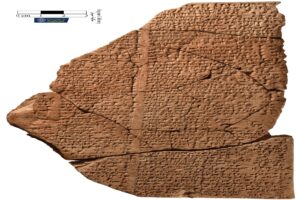At a dig in Fenstanton, a village in Cambridgeshire, eastern England, archaeologists uncovered something never before found in the U.K.
A human heelbone pierced by a nail proves the only crucifixion yet discovered in the U.K. Researchers discovered the artifact at a Roman site which also contains the remains of at least 48 individuals and some animals. The state of the preserved bones and teeth suggests poor living conditions, consistent with a large-scale industrial operation.
Albion Archaeology started the dig in 2017. Coincidentally, it began as a site evaluation for a housing developer in the area. During the survey, the Albion team identified that the site contained a previously unknown Roman settlement.

Aerial view of the excavation site. Photo: JJ Mac Ltd.
Typical discovery yields an anomaly
Overall, the discovery was relatively typical. The site lies along the Via Devana, a road that linked Cambridge and Godmanchester in the days of the Roman Empire.
Ongoing findings and research began to reflect the site’s working-class profile. In British Archaeology magazine, David Ingham, project manager at Albion, and Corinne Duhig, director of archaeology studies at Wolfson College, stated that analysis of the bones in the graves suggested widespread dental disease and bone conditions such as osteoarthritis.
Meanwhile, archaeologists at the site posited that numerous animal bones showed breaks that indicated people used them for making candles or soap.

Photo: Albion Archaeology
Then they encountered the unexpected. One of the graves held the skeleton of a man who was between 25 and 35 years old when he died. The skeleton displayed evidence of the same hardships that the rest of the site’s population endured, but an array of nails also surrounded it.
Initially, Albion workers thought that the nails indicated a burial structure like a coffin or bier. But when they cleaned the skeleton back at the lab, the nail stuck out like a…well, like a nail out of a foot.

The crucified man’s grave. Photo: Albion Archaeology
The discovery “stunned us, slightly,” Ingham told Business Insider. They proceeded to identify whether or not the skeleton was, in fact, evidence of the fourth crucifixion ever found.
Crucifixion or a crooked nail in a coffin?
Research showed that the man lived in the third or fourth century A.D. The Roman Empire banned crucifixion as a method of executing citizens in 212 A.D. However, exceptions did exist, and the ban did not protect slaves. The Fenstanton man’s burial appears respectful, which would rule out his status as a slave.
Initially, researchers entertained the remote possibility that the nail could have pierced the man’s foot while workers were nailing the coffin shut. But a human bone specialist concluded that the nail was, in fact, forced through the man’s foot, proving a crucifixion.
The finding constitutes only the fourth example of a crucifixion ever discovered. As well, it’s the best-preserved. The discovery corroborates evidence from historical texts on Roman crucifixion, and also points to a tenuous political situation at the time.
“It shows that Roman law was still applied even in the furthest provinces of the empire,” Ingham said. “The extreme west of the empire…was a pretty disturbed place by the time that this person was living. There was lots of political upheaval.”






